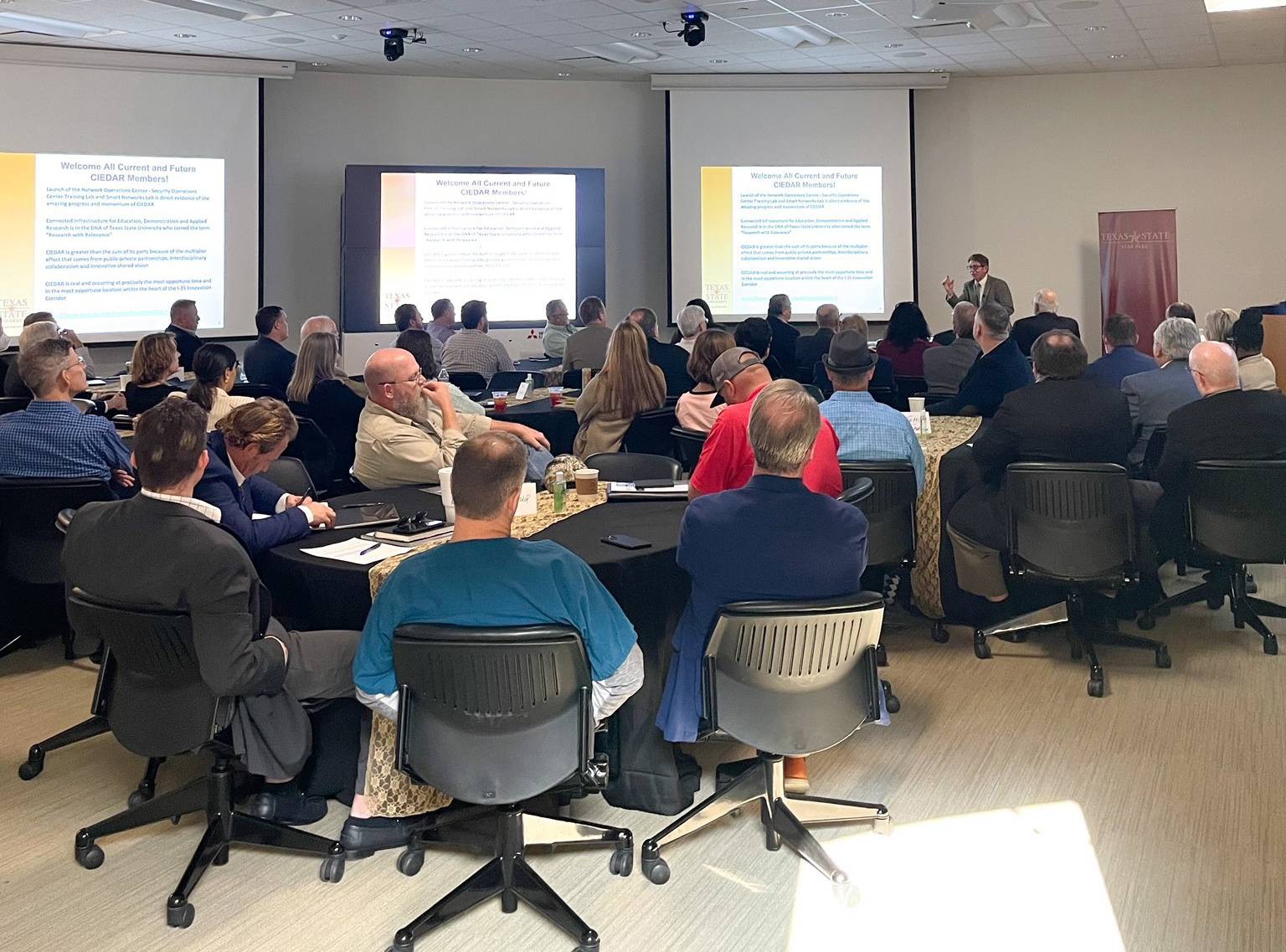Julie Cooper | January 11, 2022
Solar farms, autonomous cars, and smart homes just some of what’s in store
CIEDAR is helping drive Texas State University’s success in becoming a national research university.
Located at STAR Park, CIEDAR is the Connected Infrastructure for Education, Demonstration and Applied Research consortium under the direction of Andres Carvallo, fellow, Materials Applications Research Center and professor of innovation, and Dr. Stan McClellan, professor of Electrical and Computer Engineering. There are currently 100 faculty working on 291 projects with 250 students, in 32 laboratories and seven centers up and running.

The Science, Technology and Advanced Research (STAR) park is just one of six locations where CIEDAR operates. There are plans for hundreds of acres of solar on two university-owned ranches, 60 acres for a mobility lab, and a 50-mile stretch of road for an autonomous shuttle system between the university’s Round Rock and San Marcos campuses.
“We are building nine smart living labs with the focus of digitalization, decentralization, and decarbonization,” said co-director Carvallo. The nine smart living labs in development concentrate on utilities, buildings, energy, water/wastewater, cities, mobility, networks, sensor, and data/software.

Recently, CIEDAR held a formal launch of the Network Operations Center/Security Operations Center (NOC/SEC) Training Lab and its Smart Networks Lab in front of 70 guests and 14 member organizations. Current members in CIEDAR include Guadalupe Valley Electric Cooperative, the City of San Marcos, Riis Technology, Direct Line To compliance, Element8, Easymetering, the City of Kyle, the City of Brownsville, Anterix, Sertainty, ClearWorld, KodeLabs, Everynet, and TeMix.
Carvallo said the Network Operations Center/Security Operations Center Training Lab (NSTL) and Smart Networks Lab (SNL) will offer year-round world-class cybersecurity and compliance training for cities, utilities (electric, gas, water, and wastewater), and enterprises.
Earlier in December 2021, the Smart Networks Lab installed and is now testing its Private LTE/5G network. Carvallo said that Texas State is the only university in the nation with an experimental 900MHz FCC license for this type of network. The only other major research institution with such a license is the National Renewable Energy Lab. Plans are to open four more labs in 2022.
“We're building a smart cities lab at STAR Park and we're building the Infrastructure Research Laboratory (IRL) with the School of Engineering there as well,” Carvallo said. He said they are also building new roads that will have streetlights — LED lights and solar-powered lights — with energy storage capabilities that can operate on or off the grid.
“Our 900 MHz PLTE/5G network will enable testing of over 100 use-cases for cities and utilities managing all kinds of infrastructure in real-time and at very low latency speeds (less than 10 milliseconds). Utilities require a network like ours to manage energy in real-time at the edge of their power grid. With the addition of Solar PV Roof Tops, Home Energy Storage and Electric Vehicles everywhere, the need to real-time control by utilities will become mandatory.” Four Texas State students are currently doing testing on the 900 MHz PLTE/5G network.

In February CIEDAR will host a three-day training, “Surviving the February 2022 Grid Crash Black Swan Event. One year ago, Texas suffered when the temperatures dropped to minus zero and the state’s electrical grid under the Electric Reliability Council of Texas (ERCOT) was overwhelmed. The Texas Department of State Health Services reports that more than 210 people died during the historic freeze and blackouts. The Texas Comptroller’s office reported that the financial fallout caused by the storm last year cost Texas between $80 billion and $130 billion.
“We are going to reenact – like reenacting a battle – what took place and the folks who attend from all kinds of cities and utilities are going to relive how the grid almost went down and all the rolling blackouts that were happening,” Carvallo said. “Then we’re going to triage what to do, and what not to do and how to improve everything that went on.”
Other lab events scheduled for 2022 include a cybersecurity energy audit, how to manage data breaches, and smart grid technology.
“That's what these labs are about — to help the cities and the utilities (electric, water, and gas) really get ahead of the curve and learn how to manage these things, how to change their processes and create new best practices of how they go about running their businesses every day,” Carvallo said. “CIEDAR isn’t only helping cities and utilities with their technological wish lists – it is a multi-disciplinary research and development consortium,” he said.
In the spring CIEDAR will host a Smart Homes Lab competition with three winners chosen to design and build a home at a cost of $100 per square foot or below. CIEDAR members will sponsor up to $300,000 to build each of the three winning new smart home designs.
“What we're doing here -- one capability at a time -- is building the largest physical research and development playground ever. We are inviting the members to engage, informing them about what we're doing, and having a conversation when we gather to discuss the challenges that they want us to help with so we all understand what's possible, what's available, and what kinds of projects we can help build upon,” Carvallo said.
Share this article
For more information, contact University Communications:Jayme Blaschke, 512-245-2555 Sandy Pantlik, 512-245-2922 |
